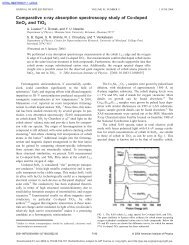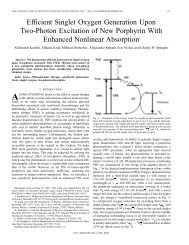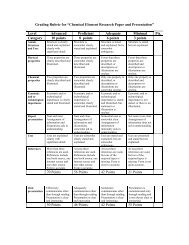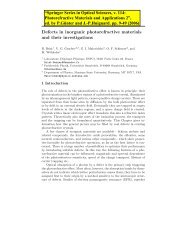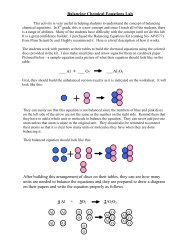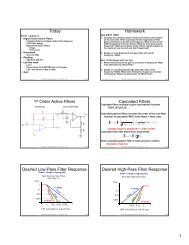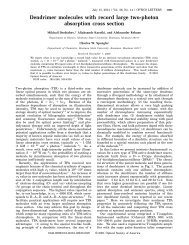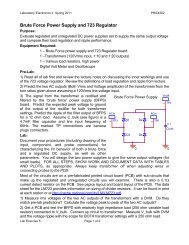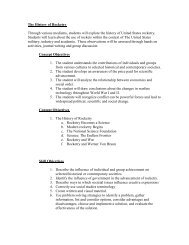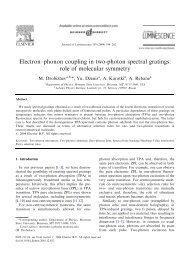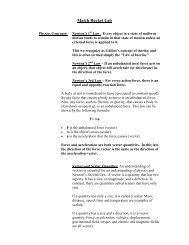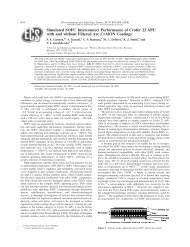Practical Uses and Applications of Electro-Optic Modulators
Practical Uses and Applications of Electro-Optic Modulators
Practical Uses and Applications of Electro-Optic Modulators
Create successful ePaper yourself
Turn your PDF publications into a flip-book with our unique Google optimized e-Paper software.
electric field, <strong>and</strong> an X-cut device uses the horizontal<br />
component. For a Z-cut device, an optical isolation<br />
layer is required to avoid increased optical losses since<br />
one <strong>of</strong> the electrodes is placed on top <strong>of</strong> the optical<br />
waveguide. All New Focus modulators use an X-cut<br />
crystal orientation in order to provide temperature stability<br />
<strong>and</strong> a propagation direction that utilizes the<br />
largest electro-optic coefficient.<br />
X<br />
Z<br />
E-field<br />
Lithium Niobate<br />
E-field<br />
Y<br />
X-cut<br />
Lithium Niobate<br />
Z-cut<br />
Waveguide<br />
Waveguide<br />
Fig. 10: Geometry <strong>of</strong> LiNbO 3 modulators.<br />
X<br />
Z<br />
Y<br />
To create a well-defined electric field within the<br />
optical waveguide, thick gold electrodes are deposited<br />
on the LiNbO 3 substrate. The modulation b<strong>and</strong>width<br />
<strong>of</strong> an integrated-optic modulator depends on the type <strong>of</strong><br />
electrode. Lower frequency modulators use lumped-element<br />
electrodes where the electrode length is small<br />
compared to the drive-signal wavelength. The modulation<br />
b<strong>and</strong>width is limited by the RC time constant <strong>of</strong><br />
the electrode capacitance <strong>and</strong> the parallel matching<br />
resistance. The parallel matching resistance is normally<br />
set to 50 Ω to allow broadb<strong>and</strong> matching to a 50-Ω<br />
driving source. It is very difficult to build a lumped-element<br />
modulator with a b<strong>and</strong>width much higher than<br />
1 GHz. The modulation b<strong>and</strong>width can be improved by<br />
using traveling-wave electrodes at the expense <strong>of</strong><br />
fabrication simplicity. Traveling-wave electrodes are<br />
designed as transmission lines, fed at one end <strong>and</strong> terminated<br />
with a resistive load at the other end. With<br />
traveling-wave electrodes, the modulator b<strong>and</strong>width is<br />
limited by the difference between the optical <strong>and</strong> RF<br />
signal’s transit times across the crystal rather than the<br />
lumped-element RC time constant. Much effort has<br />
been put into designing traveling-wave modulators<br />
where the RF <strong>and</strong> optical signals travel at the same<br />
speed, <strong>and</strong> thus, have a high b<strong>and</strong>width. Research<br />
devices have been demonstrated with over 40 GHz <strong>of</strong><br />
electrical b<strong>and</strong>width. 11 A modulator with resistively<br />
matched, traveling-wave electrodes can operate down<br />
to DC. If the traveling-wave electrodes are transformer<br />
matched, the required drive voltage is lowered, but the<br />
modulator becomes a b<strong>and</strong>-pass device <strong>and</strong> will not<br />
work down to DC.<br />
The optical wavelength <strong>of</strong> the modulator<br />
must be specified, because the waveguides <strong>and</strong> electrodes<br />
are optimized for a particular wavelength.<br />
Wavelengths that are commonly available are 1.3 µm<br />
<strong>and</strong> 1.5 µm corresponding to the low-loss windows <strong>of</strong><br />
single-mode optical fiber.<br />
For maximum efficiency, the input optical field<br />
must have a linear polarization properly aligned<br />
with the modulating electric field. Modulator chips are<br />
typically connected to polarization-maintaining (PM)<br />
fiber at the input <strong>and</strong> either PM fiber or single-mode<br />
(SM) fiber at the output using UV-curable adhesive.<br />
These fibers are commonly referred to as pigtails. To<br />
reduce optical reflections, the modulator chip is antireflection<br />
(AR) coated or angle-polished before connecting<br />
the pigtails. <strong>Optic</strong>al return loss is the ratio<br />
<strong>of</strong> the back-reflected optical power in the input fiber to<br />
the input optical power, expressed in dB. The backreflected<br />
light is generated at the interface between the<br />
fiber pigtail <strong>and</strong> the LiNbO 3 crystal. With an angle-polish,<br />
the incident light is reflected at an angle <strong>and</strong> very<br />
little reflected light is coupled back into the input fiber.<br />
The optical return loss should be less than -30 dB for<br />
most applications.<br />
Insertion loss is the optical power loss in the<br />
modulator expressed in dB. It is measured as the ratio<br />
<strong>of</strong> optical power in the input fiber to the optical power<br />
in the output fiber when the modulator is biased for<br />
maximum transmission. This value accounts for the<br />
9





